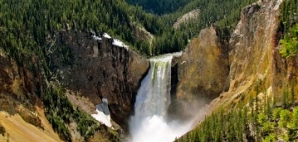Scientists Making Good Use of Those Vacation Photos You Posted Online
« Back to Stanford Woods Institute Faculty...
 Yellowstone National Park is the most-visited nature based tourist attraction in the world, as measured by Flickr photos.
Yellowstone National Park is the most-visited nature based tourist attraction in the world, as measured by Flickr photos. Photo credit: Jess Gunn
Scientists Making Good Use of Those Vacation Photos You Posted Online
Stanford scientists are using social media to study how people use natural areas for tourism and recreation.
Scientists affiliated with the Natural Capital Project, a joint venture of the Stanford Woods Institute and other organizations, have found a way to use photo-sharing site Flickr to measure where and when people are using natural areas for recreation and tourism. This information can help measure the benefits and value that these areas provide to society.
The project is the latest tool developed by the Natural Capital Project (NatCap) to quantity, map and value natural resources. NatCap works with leaders around the world to test and demonstrate how accounting for nature’s benefits can support sustainable investment and policy decisions.
Tourism is big industry, contributing $6 billion a year (9 percent of GDP) to the world economy, and it’s expected to grow to $10 billion over the next 10 years. While we know a great deal about how man-made tourist destinations, such as Disneyland, contribute to local economies, it has been hard to figure out the contribution of natural areas such as parks and beaches.
Tapping into the big data collected by social media sites, researchers at the Natural Capital Project utilized information from 1.4 million geo-tagged images in Flickr, and the user profiles associated with them, to see where people were going and where they were coming from. Comparing this information to data from on-site surveys at 836 recreational sites around the world, they found that the information from Flickr can serve as a reliable indicator of how many people visit a tourist attraction each year and when they are visiting. Their research was published today in Scientific Reports.
This is the first study to ground truth the use of social media data to predict visitation rates.
The research shows how “information from crowdsourced social media is revolutionizing the way we study people and understand their choices,” said lead author Spencer Wood.
“No one has been able to crack the problem of figuring out visitation rates and values for tourism and recreation without on-site studies until now,” said Anne Guerry, lead scientist at NatCap. Before, people had to rely on local surveys and head counts to get this type of visitation information. Using social media to get ideas of where people are recreating, and where they are coming from, is faster, less expensive and better for looking at changes over time and space.
This new approach provides the chance to clarify what attracts people to natural areas, and to determine if changes in ecosystems lead to changes in visitation rates. It also holds the promise of better natural area management because land-use planners, park managers and government officials can use the information on visitation rates to better manage their lands for the people who use them.
